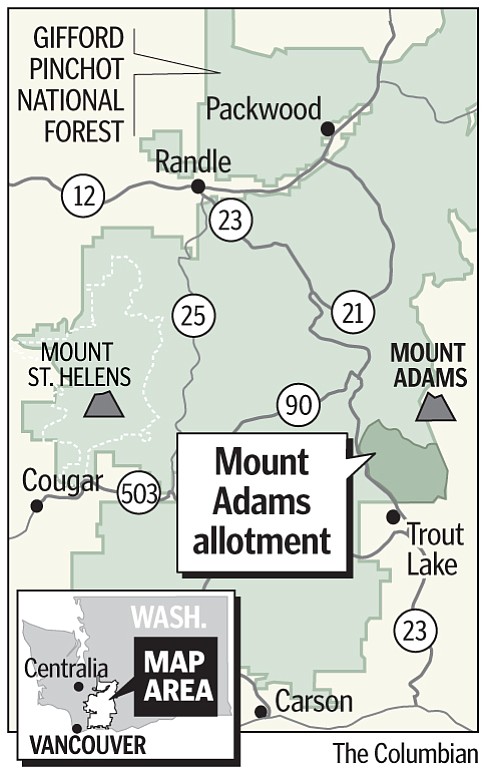As the Gifford Pinchot National Forest takes a renewed look at permitted livestock grazing near Mount Adams, conservation groups are pushing for better protection of sensitive natural areas that are supposed to be off limits.
The U.S. Forest Service has proposed renewing a 33,000-acre grazing allotment to the south of Mount Adams, allowing a Goldendale rancher to graze 516 cow-calf pairs during late summer each year. The existing permit expires in 2014. Renewing it would extend the grazing allotment for 10 years.
Local advocacy groups say they’re not opposed to using public forestland for grazing. Their worry stems from wayward cows wandering into and damaging sensitive areas outside the grazing boundaries — particularly the pristine Gotchen Creek meadows, on the mountain’s south side.
A recent meeting among Forest Service officials, Friends of Mount Adams and the Gifford Pinchot Task Force offered some encouragement, said Jurgen Hess, chairman of Friends of Mount Adams. Advocates are now hoping for better results in protecting valuable natural areas around the mountain, he said.
“There’s good words,” Hess said, “but we need to have the action follow up on that.”
Gifford Pinchot officials are working through an environmental assessment before they renew the grazing permit. The formal public comment ended earlier this week. Gifford Pinchot National Forest spokesman Chris Strebig said part of that process is balancing agricultural uses of public lands without compromising the resources they hold. The Forest Service hopes to accomplish both, he said.
Livestock grazing isn’t new to the Gifford Pinchot National Forest — far from it. The practice goes back more than a century, and the grazing allotment now under consideration has been in place since 1988, according to the Forest Service.
Much of the trespass problem stems from inadequate fencing that allows cattle to roam outside the permitted areas, Hess said. The animals can damage stream beds in the meadows, threaten fragile wildflowers and other wildlife, he said. The areas are also popular for hiking and other recreation.
As part of its environmental assessment, the Forest Service has proposed rebuilding fencing along the allotment’s northeast side to keep cattle from straying. The fence also includes a gate near a trail, said Nancy Ryke, district ranger of the Mount Adams district in the Gifford Pinchot National Forest. Sometimes, it simply gets left open by trail users, she said.
“Whenever you have a fence, there’s always the chance for cattle to get through,” Ryke said.
Ryke said fence improvements are typically a shared responsibility between the Forest Service and the rancher, Neil Kayser. Keeping tabs on the herd ultimately falls to Kayser. Ryke and others said Kayser has been responsive when a few of the animals wander outside the allotment.
The edges of the area may also see more monitoring, Ryke said — a development that Hess and others welcomed. But Ryke noted that examining Forest Service policy isn’t as simple as changing it overnight. There are required processes and procedures, and the Forest Service’s environmental assessment is part of its effort to balance all interests, she said.
Advocacy groups have welcomed what they called some progress on managing grazing, said Jessica Schafer, conservation director for the Portland-based Gifford Pinchot Task Force. That doesn’t mean the issue is completely resolved, she said.
“There’s a lot more that needs to be done,” Schafer said.
The grazing area sits at the eastern edge of the Gifford Pinchot National Forest, near its boundary with the Yakama Indian Reservation. A decision on whether to renew the grazing allotment — and what extra protection measures will be added to it — could arrive by the end of this summer.
Eric Florip: 360-735-4541; eric.florip@columbian.com.




